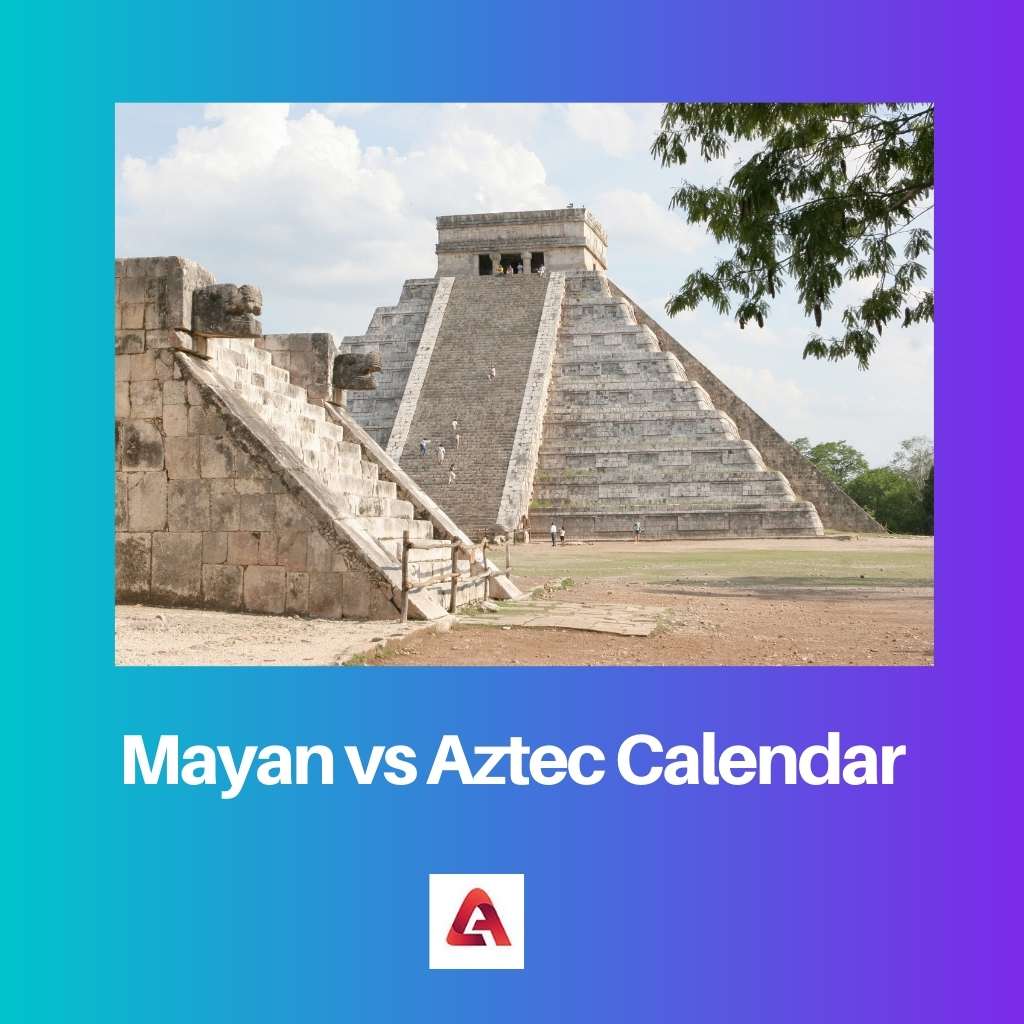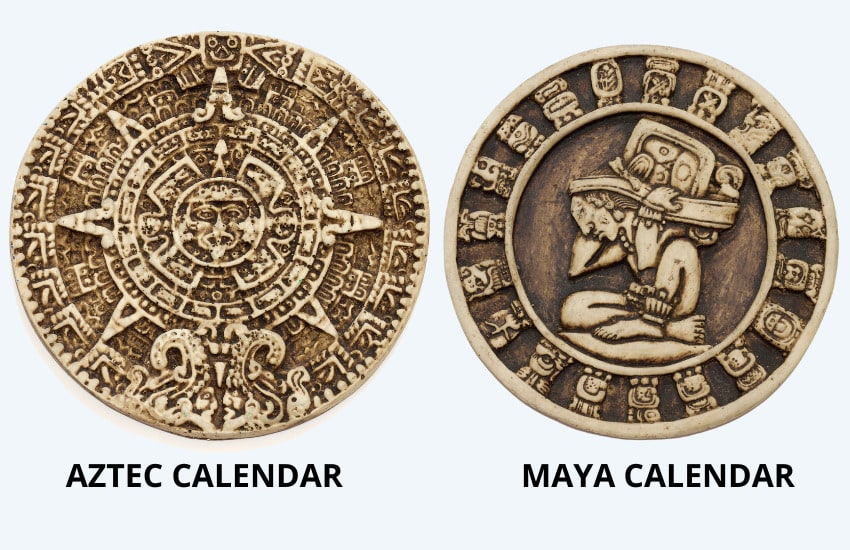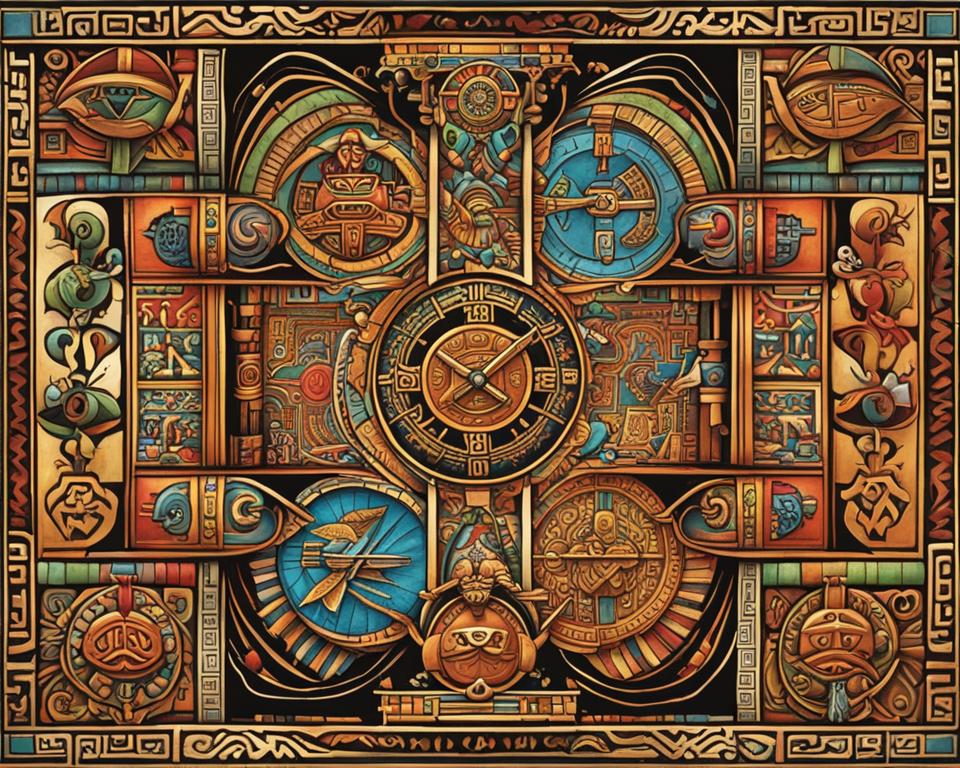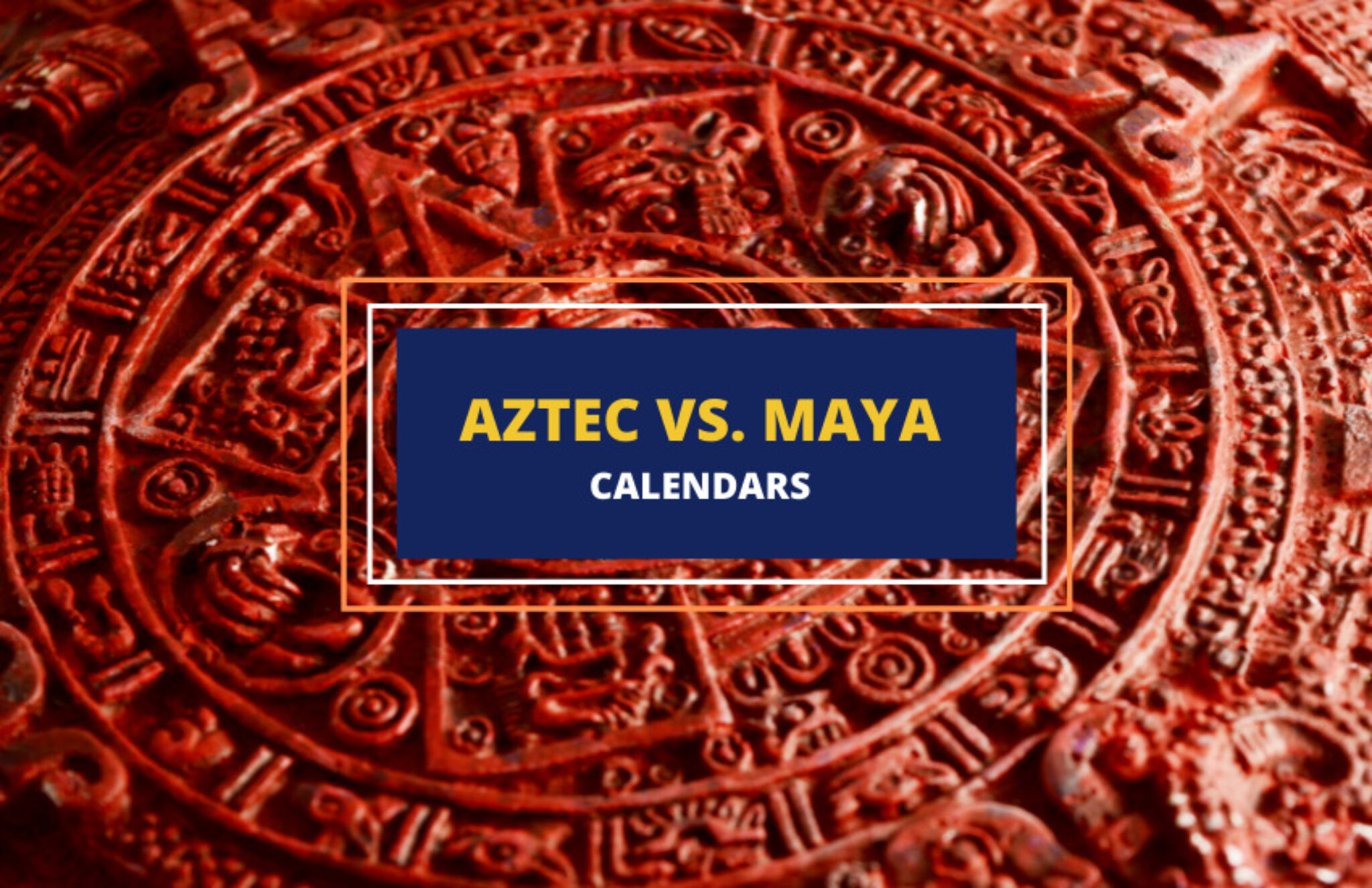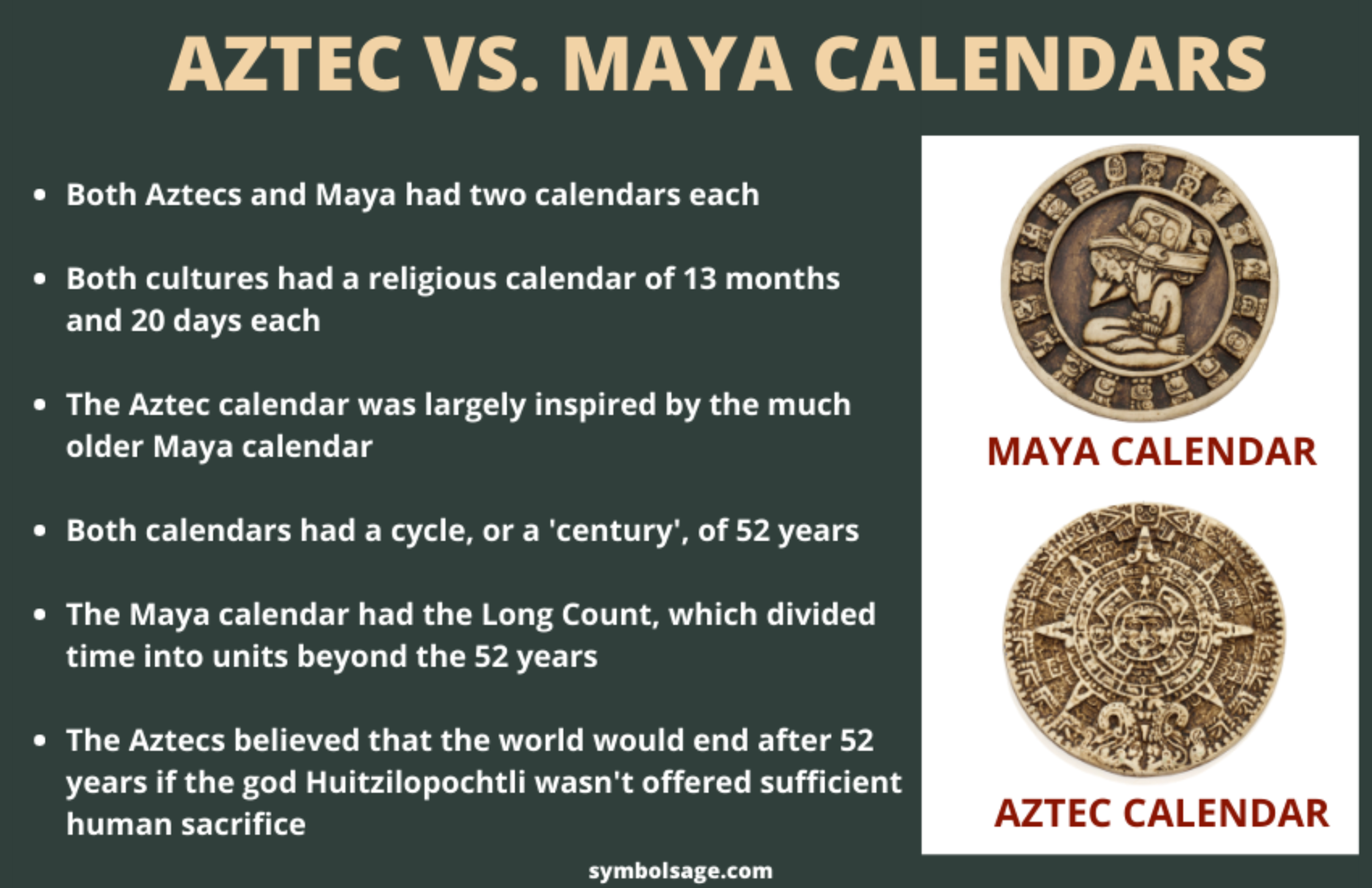Difference Between Mayan And Aztec Calendar
Difference Between Mayan And Aztec Calendar - In the mayan long count calendar, the count of cycles can reach unimaginable time. Web the mayan calendar is known for its long count system and intricate hieroglyphic inscriptions, while the aztec calendar, also known as the sun stone, is a circular calendar with various symbols representing different time cycles. The tzolkʼin calendar combines twenty day names with the thirteen day numbers to produce 260 unique days. One of the most apparent differences between the aztec and mayan civilizations is their geographical location. Web one of the major differences between the aztec vs mayan calendars that we can see is the lack of a long count calendar (mayan long count calendar). At first, we will compare the differences between the two civilizations: Web in this article, we’ll delve into a comparison of the aztec and maya calendars, exploring their similarities and differences, and shedding light on the incredible timekeeping systems of these ancient mesoamerican civilizations. Their tribute empire spread throughout mesoamerica. Unraveling the secrets of mixtec codices: There are several minor and superfluous differences between the aztec and maya calendars, with most of them being a bit too detailed for a quick article.
The aztecs and mayans are both significant ancient civilizations from mesoamerica, yet they have distinct histories, geographies, and contributions. Nonetheless, they also exhibited notable differences. Web the maya and the aztec were two of the most influential civilizations in ancient mesoamerica, spanning from central mexico to northern central america. Web the aztecs, on the other hand, used a very similar calendar that they most likely inherited from the mayans. Web the aztec and maya calendars have many similarities as they both use the original olmec calendars, but there are some key differences. Learn about their distinct calendars, gods, and cultural practices. Mayan calendar, dating system of the ancient mayan civilization and the basis for all other calendars used by mesoamerican civilizations. Unraveling the secrets of mixtec codices: The aztec calendar equivalent was called tōnalpōhualli, in the nahuatl language. Web the various names of this calendar as used by precolumbian maya people are still debated by scholars.
Insights into the ancient mexican indigenous civilization. A glimpse into the indigenous calendar systems. Geographical location, timeline and duration, political structure, writing and record keeping, language, religious beliefs, architectural achievements, arts, agriculture, and their overall legacy. Web xochipilli, a deity linked to songs, flowers, the rising sun, joy, games, and fertility, holds profound significance in aztec religion. They were primarily located in the yucatán peninsula and the highlands of. Web the aztec and maya calendars have many similarities as they both use the original olmec calendars, but there are some key differences. Web the mayan calendar is known for its long count system and intricate hieroglyphic inscriptions, while the aztec calendar, also known as the sun stone, is a circular calendar with various symbols representing different time cycles. The aztec calendar equivalent was called tōnalpōhualli, in the nahuatl language. The aztecs and mayans are both significant ancient civilizations from mesoamerica, yet they have distinct histories, geographies, and contributions. Delve into our article comparing these two ancient civilizations.
Mayan vs Aztec Calendar Difference and Comparison
Web the various names of this calendar as used by precolumbian maya people are still debated by scholars. There are several minor and superfluous differences between the aztec and maya calendars, with most of them being a bit too detailed for a quick article. In the mayan long count calendar, the count of cycles can reach unimaginable time. A glimpse.
Aztec vs Maya Calendar Similarities and Differences Symbol Sage
The calendar was based on a ritual cycle of 260 named days and a year of 365 days. Unraveling the secrets of mixtec codices: Web the mayan calendar is known for its long count system and intricate hieroglyphic inscriptions, while the aztec calendar, also known as the sun stone, is a circular calendar with various symbols representing different time cycles..
Maya vs Aztec Calendar (Explained)
Web xochipilli, a deity linked to songs, flowers, the rising sun, joy, games, and fertility, holds profound significance in aztec religion. Exploring the mayan long count calendar: The maya people lived in southern mexico and northern central america — a wide territory that includes th. Learn about their distinct calendars, gods, and cultural practices. Geographical location, timeline and duration, political.
Mayan vs Aztec Calendar Difference and Comparison
The tzolkʼin calendar combines twenty day names with the thirteen day numbers to produce 260 unique days. Web the mayan calendar is known for its long count system and intricate hieroglyphic inscriptions, while the aztec calendar, also known as the sun stone, is a circular calendar with various symbols representing different time cycles. The maya people lived in southern mexico.
Difference Between Mayan And Aztec Calendar
There are several minor and superfluous differences between the aztec and maya calendars, with most of them being a bit too detailed for a quick article. While the aztec calendar is characterized by its massive stone disc and intricate carvings, the mayan calendar is known for its complex interlocking cycles and remarkable accuracy. Web the maya and the aztec were.
Difference Between Aztec And Mayan Calendar
Exploring the mayan long count calendar: A glimpse into the indigenous calendar systems. Unraveling the secrets of mixtec codices: Web the mayan calendar is known for its long count system and intricate hieroglyphic inscriptions, while the aztec calendar, also known as the sun stone, is a circular calendar with various symbols representing different time cycles. Mayan calendar, dating system of.
Aztec vs Maya Calendar Similarities and Differences Symbol Sage
1 his name’s etymology derives from a nominal composition of the nouns xochitl meaning “flower” and pilli meaning “noble, youth.” fray bernardino de sahagún translates his name as “noble flower” or “main. The aztec calendar equivalent was called tōnalpōhualli, in the nahuatl language. Web the aztec and maya calendars have many similarities as they both use the original olmec calendars,.
Difference Between Aztec And Mayan Calendar
In the mayan long count calendar, the count of cycles can reach unimaginable time periods from the point of view of human life. Delve into our article comparing these two ancient civilizations. Web table of contents. At first, we will compare the differences between the two civilizations: The calendar was based on a ritual cycle of 260 named days and.
Difference Between Aztec And Mayan Calendar
In the mayan long count calendar, the count of cycles can reach unimaginable time. Delve into our article comparing these two ancient civilizations. Unraveling the secrets of mixtec codices: 1 his name’s etymology derives from a nominal composition of the nouns xochitl meaning “flower” and pilli meaning “noble, youth.” fray bernardino de sahagún translates his name as “noble flower” or.
Aztec vs Maya Calendar Similarities and Differences Symbol Sage
1 his name’s etymology derives from a nominal composition of the nouns xochitl meaning “flower” and pilli meaning “noble, youth.” fray bernardino de sahagún translates his name as “noble flower” or “main. Web both calendars demonstrate the advanced astronomical knowledge and cultural sophistication of the aztecs and mayans. They were primarily located in the yucatán peninsula and the highlands of..
There Are Several Minor And Superfluous Differences Between The Aztec And Maya Calendars, With Most Of Them Being A Bit Too Detailed For A Quick Article.
The largest difference between the two was that the aztecs used sequences of 20 and 13 days and would use these to measure months and various religious holidays. One of the most apparent differences between the aztec and mayan civilizations is their geographical location. Both societies boasted intricate civilizations marked by notable similarities. In the mayan long count calendar, the count of cycles can reach unimaginable time periods from the point of view of human life.
Web The Aztecs, On The Other Hand, Used A Very Similar Calendar That They Most Likely Inherited From The Mayans.
At first, we will compare the differences between the two civilizations: While the aztec calendar is characterized by its massive stone disc and intricate carvings, the mayan calendar is known for its complex interlocking cycles and remarkable accuracy. Web differences between the mayan and aztec civilizations. Insights into the ancient mexican indigenous civilization.
Geographical Location, Timeline And Duration, Political Structure, Writing And Record Keeping, Language, Religious Beliefs, Architectural Achievements, Arts, Agriculture, And Their Overall Legacy.
1 his name’s etymology derives from a nominal composition of the nouns xochitl meaning “flower” and pilli meaning “noble, youth.” fray bernardino de sahagún translates his name as “noble flower” or “main. Mayan calendar, dating system of the ancient mayan civilization and the basis for all other calendars used by mesoamerican civilizations. The aztecs and mayans are both significant ancient civilizations from mesoamerica, yet they have distinct histories, geographies, and contributions. Web one of the major differences between the aztec vs mayan calendars that we can see is the lack of a long count calendar (mayan long count calendar).
Web Xochipilli, A Deity Linked To Songs, Flowers, The Rising Sun, Joy, Games, And Fertility, Holds Profound Significance In Aztec Religion.
Unraveling the secrets of mixtec codices: Nonetheless, they also exhibited notable differences. Web what's the difference between aztecs and mayans? Web both calendars demonstrate the advanced astronomical knowledge and cultural sophistication of the aztecs and mayans.
